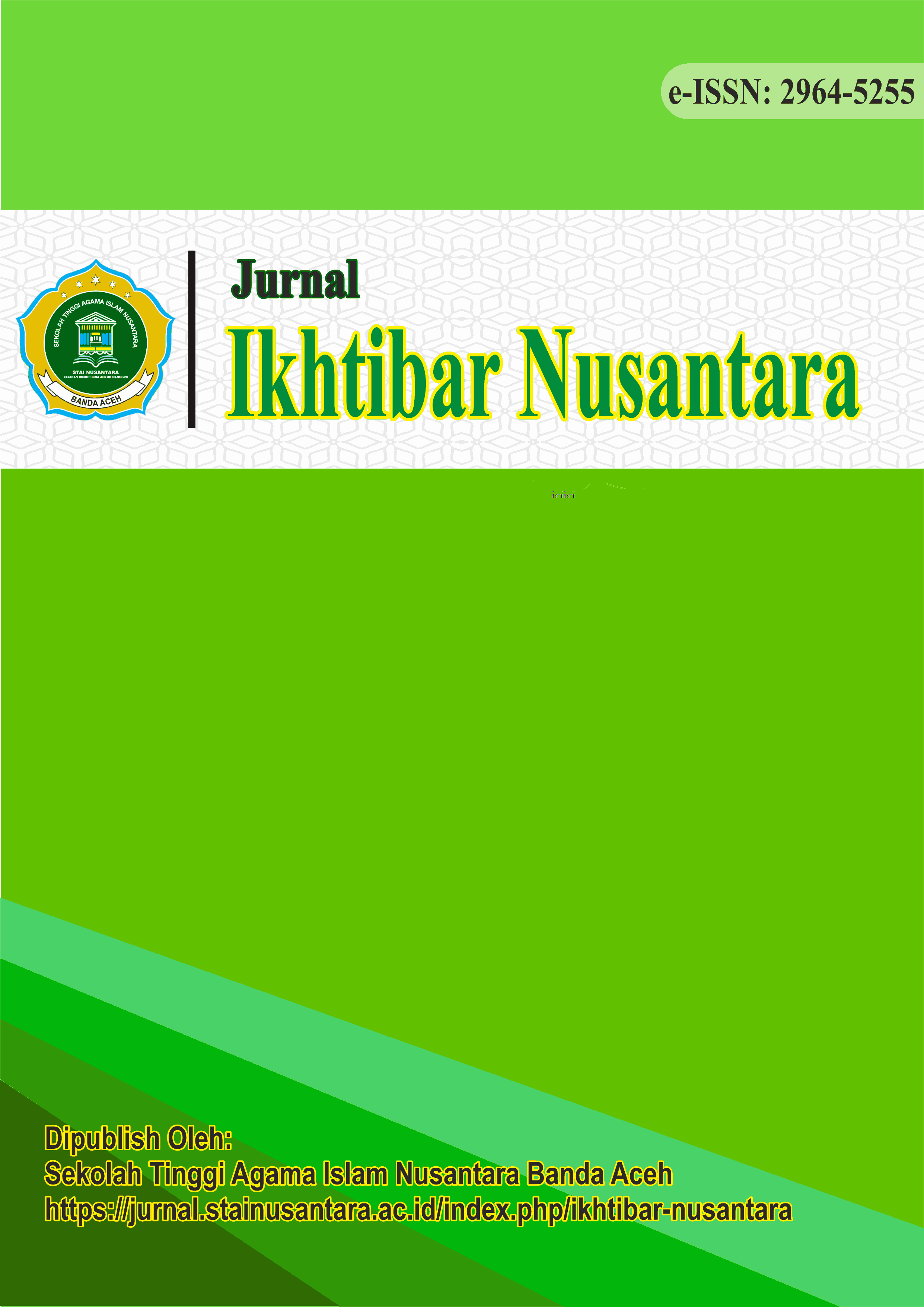THE EDUCATIVE VALUE IN THE HADITH “ṢALLŪ KAMĀ RAʾAYTUMŪNĪ UṢALLĪ”: A PEDAGOGICAL ANALYSIS OF PROPHETIC INSTRUCTION
DOI:
https://doi.org/10.62901/j-ikhsan.v4i1.220Keywords:
Educative Value, Hadith, Ṣallū Kamā Raʾaytumūnī Uṣallī, Prophetic Model, Islamic Education, PrayerAbstract
This study aims to examine the educational values contained in the Hadith of Prophet Muhammad ﷺ ” صَلُّوا كَمَا رَأَيْتُمُونِي أُصَلِّي” (Pray as you see me praying). This hadith is not only the main guideline in the procedure of prayer, but also contains holistic and applicable principles of Islamic education. This research uses the library research method by examining various relevant literature sources. The sanad of the hadith, the quality of the narrators, and the content (matan) of the hadith were analyzed to assess its validity and educational value. The results show that the Hadith contain the value of exemplary (uswah hasanah), visual and practical learning, internalization of the meaning of worship, the importance of standardization in education, and the need for active interaction between educators and students. These values are very relevant in building an Islamic education system that touches the spiritual, intellectual, and emotional aspects of students. Therefore, this hadith is not only important in the fiqh aspect of worship, but can also be used as a basis for developing a contextual and effective approach to Islamic education in the modern era.
References
ʻAbd al-Baqi, M. F. (1996). Al-Muʻjam al-mufahras li alfāẓ al-ḥadīth al-nabawī. Beirut: Dār al-Fikr.
Ad-Damsyiqi, I. H. H. (2011). Asbabul Wurud: Latar Belakang Historis Timbulnya Hadits Hadits Rasul. Jilid 2. Jakarta: Kalam Mulia.
Al-Asqalani, I. H. (2021). Fathul Baari: Penjelasan Kitab Shahih Al-Bukhari. Jilid 7. Jakarta: Pustaka Azzam.
Al-Bukhari, M. I. (n.d.). Shahih al-Bukhari (Versi Digital, Maktabah al-Syamilah v.3.28). https://shamela.ws.
Alwi, Z. et al. (2021). Studi Ilmu Hadis. Depok: Rajawali Pers.
Ensiklopedi Hadits (Versi Mobile, v19.0.1). (n.d). https://play.google.com/store/apps/details?id=com.saltanera.hadits.
Erizon et al. (2022). “Nilai-Nilai Pendidikan Dalam Salat: Studi Teks Dalam Tafsir Al-Misbah.” At-Tajdid : Journal of Islamic Studies, 2 (2). https://doi.org/10.24014/at-tajdid.v2i2.18446.
Firmansyah. (2020). “Karakter Pendidik dalam Pembelajaran Menurut Hadits.” Jurnal Ilmiah Edukatif, 6 (1). https://doi.org/10.37567/jie.v6i1.103.
Firmansyah. (2022). “Motivasi Motivasi dalam Proses Pembelajaran dalam Perspektif Hadits.” Jurnal Ilmiah Edukatif, 8 (1). https://doi.org/10.37567/jie.v8i1.1147.
HaditsSoft (Versi Digital, v4.0). (n.d). https://haditssoft.software.informer.com/.
Hadits Tazkia (Versi Digital). (2020). https://hadits.tazkia.ac.id/.
Hanifa, M. S. et al. (2022). “Kriteria Kesahihan Hadits Menurut Nashiruddin Albani Dan Ahmad Al-Ghumari.” Jurnal Riset Agama, 2 (2). https://doi.org/10.15575/jra.v2i2.17013.
Masitoh, D. (2023). “Telaah Konsep Pendidikan Islam Dalam Perspektif Hadits.” Jurnal Ilmiah Edukatif, 9 (2). https://doi.org/10.37567/jie.v9i2.2555.
Muchtar, E. H. (2022). Analisis Deskriptif Kitab Shahih Al-Bukhari. Jurnal Ilmu Al-Qur'an dan Tafsir (JIQTA), 1(1). https://jurnal.asy-syukriyyah.ac.id/index.php/JIQTA/article/view/187.
Mustaqim, R. (2019). “Af’al Rasul Dan Implikasinya Terhadap Hukum Fikih.” Tadabbur: Jurnal Peradaban Islam, 1 (2). https://doi.org/10.22373/tadabbur.v1i2.13.
Nurhuda, A. and Setyaningtyas, N. A. (2021). “Nilai-Nilai Edukatif dalam Surat Al Kautsar beserta Implikasinya dalam Kehidupan (Tela’ah Tafsir Al Qurthubi).” Social Science Studies, 1 (3). https://doi.org/10.47153/sss13.2332021.
Purnama, Y. (2020). Salatlah Sebagaimana Melihatku Salat. Yogyakarta: Fawaid KangAswad Publishing, 2020.
Qur’an Kemenag (Versi Digital). (2022). https://quran.kemenag.go.id/.
Rofiah, K. (2018). Studi Ilmu Hadits. Jawa Timur: IAIN PO Press.
Siregar, H. and Fahmi, F. (2023). Metodologi Penelitian (Sebuah Pengantar Bidang Pendidikan). Yogyakarta: Jejak Pustaka.
Suhaimi, I. and Zabidi A. F. M. (2021). Imam Bukhari dan Muslim sebagai Tauladan Pelajar Hadis Masa Kini. Jurnal Wacana Sarjana, 5(3). https://spaj.ukm.my/jws/index.php/jws/article/view/421.
Sukma, D. T. M. et al. (2023). Muhammadiyah Sebagai Gerakan Islam yang Berwatak Tadjid dan Tajrid. Tarim: Journal Islamic Education, 1(2). http://jurnal.um-tapsel.ac.id/index.php/tarim/article/view/14504.
Sukmadinata, N. S. (2010). Metode Penelitian Pendidikan. Cet. ke-6. Bandung: Remaja Rosdakarya.
Tamjidnoor. (2022). “Pendidikan Islam Dalam Perspektif Hadits.” Edukatif : Jurnal Ilmu Pendidikan, 4 (6). https://doi.org/10.31004/edukatif.v4i6.4093.
Downloads
Published
How to Cite
Issue
Section
License
Copyright (c) 2025 Cut Nyak Marlina, Syabuddin, Sri Suyanta, Zuhra Intan

This work is licensed under a Creative Commons Attribution-ShareAlike 4.0 International License.












